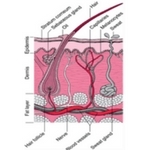Know your skin | Function of the epidermis
Function of the epidermis
The skin has three layers—the epidermis, dermis, and fat layer (also called the subcutaneous layer). Each layer performs specific tasks. The epidermis is the relatively thin, though, outer layer of the skin. The outermost portion of the epidermis, known as the stratum corneum, is relatively waterproof and, when undamaged, prevents most bacteria, viruses, and other foreign substances from entering the body.
Epidermis: The upper or outer layer of the two main layers of cells that make up the skin. The epidermis is mostly made up of flat, scale-like cells called squamous cells. Under the squamous cells are round cells called basal cells. The deepest part of the epidermis also contains melanocytes. These cells produce melanin, which gives the skin its color.
The other main layer of the skin is the dermis, the inner layer of skin that contains blood and lymph vessels, hair follicles, and glands. These glands produce sweat, which helps regulate body temperature, and sebum, an oily substance that helps keep the skin from drying out. Sweat and sebum reach the skin’s surface through tiny openings called pores.
Gentle care for newbie skin & experienced skin
01. Layer of the skin

In adults, the stratum corneum is composed of 25 to 30 layers of flattened dead keratinocytes, which are continuously shed and replaced from below. These dead cells are interlaid with lipids secreted by the stratum granulosum just underneath, which help to make this layer of the skin a waterproof barrier. In infants, this layer of the skin is much thinner and more easily disrupted and as a consequence more vulnerable.
02. Diaper dermatitis
 Irritant diaper dermatitis develops when the skin is exposed to prolonged wetness. Excessive wetting of the stratum corneum causes maceration and makes the skin more susceptible to frictional damage. It is also known that urine changes the pH of the skin from acid to alkaline; under alkaline conditions the faecal enzymes will be activated and will act as irritants of the skin inducing inflammatory responses of the skin.
Irritant diaper dermatitis develops when the skin is exposed to prolonged wetness. Excessive wetting of the stratum corneum causes maceration and makes the skin more susceptible to frictional damage. It is also known that urine changes the pH of the skin from acid to alkaline; under alkaline conditions the faecal enzymes will be activated and will act as irritants of the skin inducing inflammatory responses of the skin.
Overall, the above described conditions result in softening and/or breaking down of the stratum corneum and a greatly increased susceptibility to friction injury, resulting in Irritant Diaper Dermatitis, diaper rash! See also Diaper rash.






